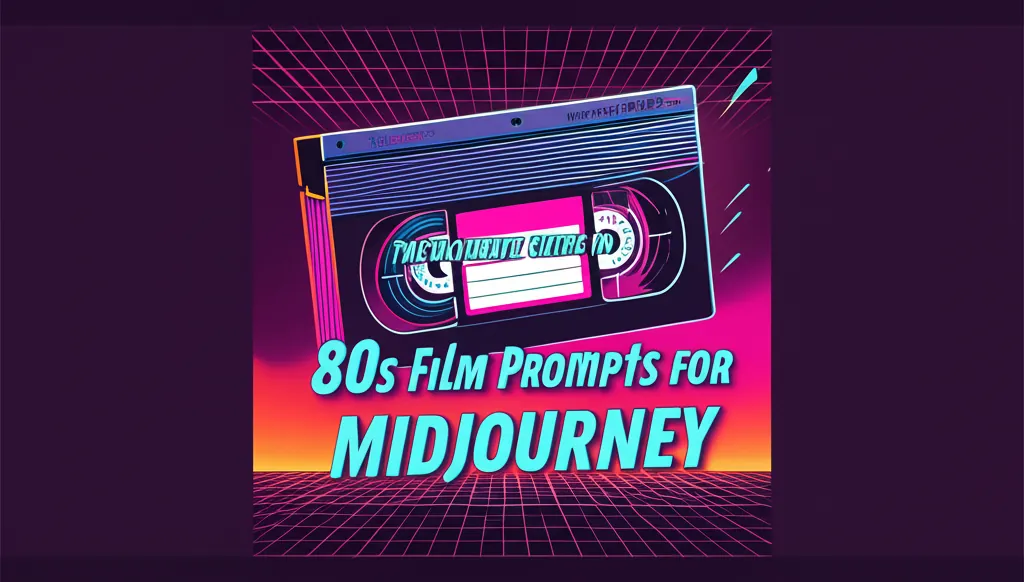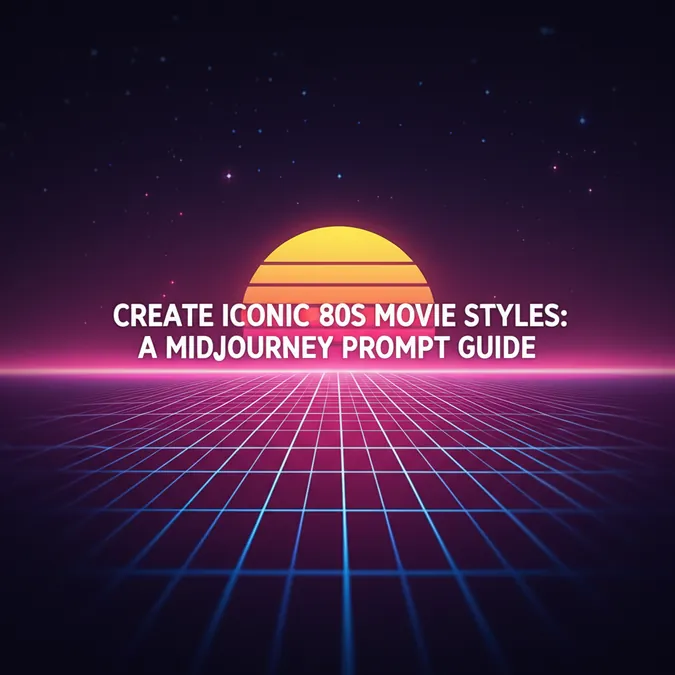Developer Offer
Try ImaginePro API with 50 Free Credits
Build and ship AI-powered visuals with Midjourney, Flux, and more — free credits refresh every month.
Master Retro Film Aesthetics with Midjourney AI Art
Master Retro Film Aesthetics with Midjourney AI Art
This guide provides the essential prompts, parameters, and techniques you need to generate authentic 80s movie-style visuals using Midjourney's AI.
The 1980s weren't just a decade; they were an aesthetic. From the neon-soaked streets of cyberpunk thrillers to the warm, hazy glow of suburban adventures, 80s cinema has a distinct and unforgettable visual language. For developers, designers, and creative professionals, replicating this iconic retro film aesthetic with Midjourney opens up a universe of creative possibilities. But achieving that perfect blend of nostalgia, grit, and cinematic flair requires more than a simple prompt. It demands an understanding of the key ingredients that defined the era's filmmaking.
This comprehensive guide will walk you through the entire process, from deconstructing the anatomy of a perfect prompt to mastering the technical parameters that bring your vision to life. We'll explore genre-specific prompts, advanced techniques, and answer the most common questions to help you create stunning 80s movie style AI art.
The Anatomy of an 80s Film Prompt: Key Ingredients
A successful Midjourney prompt is a recipe. To bake an 80s masterpiece, you need the right ingredients. Combining these elements gives Midjourney the specific instructions it needs to move beyond generic images and create something truly evocative.
- Subject & Action: What is the core focus? (e.g., "a determined teenage girl on a BMX bike," "a grizzled detective in a trench coat").
- Setting & Environment: Where does the scene take place? Be specific. (e.g., "a foggy suburban street at dusk," "a cluttered video rental store interior," "a rain-slicked neon-lit alleyway").
- Era-Specific Details: Ground your scene in the 80s. (e.g., "big hair and acid-wash jeans," "a boxy Volvo station wagon," "a vintage boombox on a shoulder").
- Lighting & Mood: This is crucial for the 80s feel. Use terms like "dramatic volumetric lighting," "soft, hazy afternoon sun," "hard-edged neon glow," or "Spielbergian magic hour." This directly influences the 80s cinematic lighting prompts.
- Film & Camera Language: Instruct Midjourney on the "how." (e.g., "shot on Kodak Kodachrome 35mm film," "anamorphic lens flare," "a still from an 80s sci-fi movie," "VHS screen grab").
- Midjourney Parameters: Technical commands that fine-tune the output, which we'll cover in a dedicated section.
Master Prompts: Creating Iconic 80s Film Aesthetics
Here are starter prompts organized by classic 80s genres. Use these as a foundation and swap out subjects, settings, and details to create your own unique scenes.
80s Sci-Fi & Cyberpunk (Blade Runner, Tron, Akira)
This genre is defined by high-contrast lighting, rain, neon, and a fusion of futuristic tech with urban decay. Generating 80s neon noir style with AI is a popular goal that fits perfectly here.
A lone figure in a long coat stands in a rain-slicked, neon-lit alleyway in Neo-Tokyo, holographic advertisements flicker on the grimy walls, shot on 35mm film, atmospheric, style of Akira --ar 16:9 --style raw
Interior of a spaceship's cockpit, retro-futuristic control panels with glowing green buttons and CRT screens, a view of a nebula outside the window, cinematic still from an 80s sci-fi epic, anamorphic lens flare --ar 2.39:1
A sleek, futuristic motorcycle speeds down a digital highway, leaving a trail of light, inside a computer world, style of Tron (1982), vibrant neon grid lines, dynamic action shot --ar 16:9
Portrait of a cynical cyborg detective in a dimly lit bar, smoke curling in the air, hard-edged neon noir lighting casting deep shadows, detailed cybernetic eye, style of Blade Runner --ar 3:2
A massive, sprawling cityscape in the year 2019 as envisioned in the 1980s, flying cars weave between towering skyscrapers, heavy smog, film still from a lost 80s cyberpunk anime --ar 16:9 --v 6.0
80s Horror & Thriller (John Carpenter, Body Horror)
80s horror relied on atmosphere, practical effects, and a sense of suburban dread. Key elements include high-contrast shadows, fog, and a grainy film look.
A group of teenagers gathered around a campfire in a dark forest, telling scary stories, the firelight casting long, dancing shadows on their faces, film still from an 80s slasher movie, shot on grainy 35mm film --ar 16:9
A grotesque body-horror creature made of melting flesh and wires, in a sterile laboratory setting, harsh fluorescent lighting, style of David Cronenberg, extremely detailed practical effects --ar 4:3
The view from inside a closet, looking out through the slats at an empty, dimly lit child's bedroom, a sense of ominous dread, style of John Carpenter, high contrast, deep shadows --ar 16:9
A haunted-looking Victorian house on a hill silhouetted against a stormy sky, lightning flashes, a still from an 80s ghost story film, moody and atmospheric --ar 3:2 --stylize 250
VHS screen grab of a news report about a mysterious event in a small town, low-resolution quality, tracking lines, timestamp in the corner, authentic 80s broadcast aesthetic --ar 4:3
80s Adventure & Fantasy (The Goonies, Labyrinth)
Characterized by warm, golden-hour lighting, a sense of wonder, and grand, tangible fantasy worlds. Anamorphic lenses were often used to create an epic feel.
A group of kids on BMX bikes parked at the edge of a cliff, looking down at a pirate ship in a hidden cove, golden hour lighting, Spielbergian sense of wonder, anamorphic lens flare, shot from the movie The Goonies --ar 2.39:1
A majestic fantasy puppet creature, wise and ancient, in an enchanted forest, soft dappled light filtering through the canopy, style of Jim Henson's Labyrinth, rich textures, cinematic --ar 16:9
A young hero holding a glowing sword aloft inside a dark, treasure-filled cavern, dramatic low-angle shot, style of an 80s fantasy movie poster --ar 2:3
An old, dusty map spread out on a wooden table, lit by a lantern, revealing secrets and treasure, detailed and intricate, a key prop from an 80s adventure film --ar 3:2
80s Teen Movies & High School Classics (John Hughes)
This aesthetic is all about soft focus, authentic fashion, and capturing the emotional highs and lows of adolescence.
A teenage girl with big 80s hair and a pastel outfit talking on a corded phone in her messy bedroom, posters on the wall, soft afternoon light coming through the window, still from a John Hughes movie --ar 3:2
The awkward high school dance, teenagers in formal wear under a disco ball, cinematic, a blend of hope and anxiety, 1986 high school prom, soft focus --ar 16:9
A classic 80s high school hallway, students at their lockers between classes, vibrant fashion, shot on 35mm film with a slightly hazy, nostalgic quality --ar 16:9
Technical Guide: Essential Midjourney Parameters for a Vintage Look
Prompts are only half the battle. To truly nail the retro film aesthetic in Midjourney, you need to use parameters. These are commands added to the end of your prompt (e.g., --ar 16:9).
How to Add Film Grain and VHS Effects
The pristine clarity of a default AI image is the enemy of the 80s look. You need to introduce imperfections.
- Prompt Language: Start by including terms like "shot on Kodak Ektachrome," "35mm film grain," "VHS screen grab," "blurry," "low-resolution," and "analog distortion."
--style raw: This parameter reduces Midjourney's default "opinionated" aesthetic. It gives you more granular control and helps Midjourney listen more closely to your specific requests for grain and vintage color, rather than trying to "beautify" the image.--stylize [0-1000]: Lowering the stylize value (e.g.,--stylize 100or--stylize 250) can also help. It tells Midjourney to stick closer to your prompt's literal instructions rather than applying its own artistic interpretation, which is useful when you've already described a "flawed" analog look.
Nailing the Aspect Ratio for a Cinematic Feel
The shape of your image is a powerful storytelling tool. The 80s had two dominant cinematic formats.
--ar 16:9(Widescreen): This is the standard for most modern television and was a common format for movies made for TV or home video during the era. It's a versatile, all-purpose cinematic ratio.--ar 2.39:1(CinemaScope): This ultra-wide aspect ratio was used for epic theatrical releases like adventure and sci-fi films. Using it instantly gives your image a grand, cinematic scope. It's perfect for landscapes, action sequences, and establishing shots.
Using Style References (--sref) with 80s Movie Stills
Introduced in Midjourney v6, the style reference parameter is a game-changer.
- How it Works: Find a URL for an image that has the exact aesthetic you want—a still from a John Carpenter film, a screenshot of Akira, etc. Add
--sref [URL]to the end of your prompt. - Application: Midjourney will analyze the style, color, and composition of the reference image and apply it to your generated subject. This is the most direct way to emulate a specific director's or film's look without having to describe it in words. For a deeper dive into parameters, the official Midjourney documentation is an invaluable resource.
FAQ: Your 80s Midjourney Questions Answered
How do I make my Midjourney images look like an 80s film?
Combine descriptive language (film stock, lighting, era-specific details) with technical parameters. Use phrases like "shot on 35mm film," specify 80s cinematic lighting prompts like "volumetric light," and use --ar 16:9 or --ar 2.39:1 to set the cinematic frame.
What are the best Midjourney prompts for an 80s look?
The best prompts are highly specific. Instead of "80s car," write "A red 1985 Ferrari Testarossa driving down a Miami street at sunset, palm trees, neon signs, shot on Kodak film." See the genre-specific lists in this guide for dozens of examples.
What are the essential parameters for a vintage aesthetic in Midjourney?
The most critical parameters are --ar for aspect ratio (use 16:9 or 2.39:1), --style raw to reduce Midjourney's default aesthetic and allow for a more authentic, gritty look, and --sref [URL] to directly copy the style of a reference image.
How do I get the 80s anime style like Akira in Midjourney?
Be explicit. Use prompts like: "A massive explosion in Neo-Tokyo, detailed urban destruction, hand-drawn anime style of Katsuhiro Otomo's Akira, cinematic, 1988 anime aesthetic, high detail, film grain --ar 16:9". Using --sref with a still from the film is also highly effective.
How to add film grain and VHS effects in a Midjourney prompt?
Directly ask for it in the prompt with terms like "heavy film grain," "VHS screen grab," "analog video distortion," "low fidelity," and "scan lines." Combining this with --style raw will yield the most authentic results.
Beyond the Basics: Related Aesthetics & Automation
Mastering the 80s aesthetic is a fantastic starting point. The same principles of deconstruction—analyzing lighting, film stock, and composition—can be applied to other eras. You can explore the gritty, desaturated look of 70s sci-fi (Alien, Silent Running) or the grunge and gloss of 90s cinema (Pulp Fiction, The Matrix).
For developers and power users, the real magic happens with automation. Manually tweaking each prompt to test different directors or lighting styles is time-consuming. By using an API, you can programmatically generate hundreds of variations. For instance, services like imaginepro.ai provide a Midjourney API, allowing you to build scripts that loop through lists of directors, years, and film stocks to rapidly prototype creative ideas. This workflow transforms a manual art project into a powerful, scalable content generation engine, perfect for creating unique assets or exploring aesthetics at scale.
Compare Plans & Pricing
Find the plan that matches your workload and unlock full access to ImaginePro.
| Plan | Price | Highlights |
|---|---|---|
| Standard | $8 / month |
|
| Premium | $20 / month |
|
Need custom terms? Talk to us to tailor credits, rate limits, or deployment options.
View All Pricing Details

